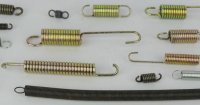欢迎阅读本篇关于O型拉伸弹簧国标的博文。作为一名技术写手,我将详细介绍O型拉伸弹簧国标的相关知识和应用领域。希望通过本文的阅读,您能够对O型拉伸弹簧国标有更全面的了解。
O型拉伸弹簧国标简介
首先,让我们来介绍一下O型拉伸弹簧国标的基本概念。O型拉伸弹簧国标是一种常见的机械弹性元件,其横截面呈圆环状,因此得名为O型弹簧。O型拉伸弹簧国标具有优良的拉伸性能和力学特性,被广泛应用于机械制造、汽车工业、电子设备等领域。
O型拉伸弹簧国标的特点
O型拉伸弹簧国标具有以下几个主要特点:
- 材料选择广泛:O型拉伸弹簧国标可以使用多种材料制作,如碳钢、不锈钢、合金钢等。根据具体应用场景和要求,选择适合的材料可以提高弹簧的功能和寿命。
- 弹性恢复性能好:O型拉伸弹簧国标具有较高的弹性恢复性能,即在受力后能够迅速恢复原状,不易永久变形。
- 可调性强:通过选择不同的材料、线径、匝数等参数,可以调节O型拉伸弹簧国标的弹性系数和强度,满足不同的使用需求。
- 体积小、重量轻:O型拉伸弹簧国标相比其他类型的弹簧,体积小、重量轻,便于安装和运输。
- 稳定的力学性能:O型拉伸弹簧国标经过国家标准化组织的严格规定和检测,具有较为稳定的力学性能和可靠性。
O型拉伸弹簧国标的应用领域
由于O型拉伸弹簧国标的优良性能和多样化的规格选择,它在许多领域都得到了广泛应用。
1. 机械制造:O型拉伸弹簧国标常用于机械制造中的弹性连接、减震、缓冲等部位。通过调节和选择不同的弹簧参数,可以使机械结构具有更好的运动特性和可靠性。
2. 汽车工业:汽车是O型拉伸弹簧国标的重要应用领域之一。它被广泛用于汽车悬挂系统、座椅调节、发动机等部位,起到减震、缓冲、支撑等作用。
3. 电子设备:O型拉伸弹簧国标在电子设备中也有广泛应用,如按钮开关弹簧、插座连接弹簧等。它们具有体积小、重量轻、回弹力强、使用寿命长的特点,适合在极小空间内起到稳定和可靠的连接作用。
O型拉伸弹簧国标的选型和设计
在选择和设计O型拉伸弹簧国标时,需要考虑以下几个方面:
- 受力条件:根据受力条件确定所需的弹簧参数,如弹簧的弹性系数、工作长度、工作载荷等。
- 材料选择:根据使用环境和要求选择合适的材料,考虑其耐腐蚀性、耐疲劳性、强度等指标。
- 弹簧参数计算:根据所需的工作载荷、变形量等参数,进行合理的弹簧设计和计算,确保弹簧满足使用要求。
- 弹簧的可靠性和寿命:在选型和设计过程中,需要考虑弹簧的可靠性和寿命,确保弹簧在使用过程中不会出现失效或性能下降的情况。
总结
通过本文的介绍,我们对O型拉伸弹簧国标有了更深入的认识。它是一种常见的弹性元件,具有优良的力学性能和广泛的应用领域。在选择和设计O型拉伸弹簧国标时,我们需要考虑受力条件、材料选择、弹簧参数计算以及可靠性和寿命等方面。希望本文对您有所帮助,谢谢阅读!
(Translation) htmlWelcome to this blog post about the national standard for O-shaped extension springs. As a technical writer, I will provide a detailed introduction to the relevant knowledge and application areas of O-shaped extension springs. I hope that through reading this article, you will have a more comprehensive understanding of the national standard for O-shaped extension springs.
Introduction to the National Standard for O-shaped Extension Springs
Firstly, let us introduce the basic concept of the national standard for O-shaped extension springs. The national standard for O-shaped extension springs is a commonly used mechanical elastic component with a circular cross-section, hence the name O-shaped spring. O-shaped extension springs have excellent stretching performance and mechanical properties, and are widely used in mechanical manufacturing, automotive industry, electronic equipment, and other fields.
Characteristics of the National Standard for O-shaped Extension Springs
The national standard for O-shaped extension springs has the following main characteristics:
- Wide material selection: O-shaped extension springs can be made from various materials such as carbon steel, stainless steel, alloy steel, etc. By selecting the appropriate material based on specific application scenarios and requirements, the spring's functionality and lifespan can be improved.
- Good elastic recovery performance: O-shaped extension springs have high elastic recovery performance, meaning they can quickly return to their original state after being under stress without permanent deformation.
- High adjustability: By choosing different parameters such as material, wire diameter, number of coils, etc., the elastic coefficient and strength of O-shaped extension springs can be adjusted to meet different usage requirements.
- Small size and light weight: Compared to other types of springs, O-shaped extension springs have a smaller size and lighter weight, making them easy to install and transport.
- Stable mechanical performance: The national standard for O-shaped extension springs undergoes strict regulations and testing by national standardization organizations, ensuring relatively stable mechanical performance and reliability.
Application Areas of the National Standard for O-shaped Extension Springs
Due to the excellent performance and diverse specification options of the national standard for O-shaped extension springs, it has been widely used in various fields.
1. Mechanical Manufacturing: O-shaped extension springs are often used in elastic connections, shock absorption, cushioning, and other parts in mechanical manufacturing. By adjusting and selecting different spring parameters, mechanical structures can have better motion characteristics and reliability.
2. Automotive Industry: The automotive industry is one of the important application areas of O-shaped extension springs. They are widely used in automotive suspension systems, seat adjustments, engines, etc., playing roles in shock absorption, cushioning, support, etc.
3. Electronic Equipment: O-shaped extension springs also have wide applications in electronic devices, such as button switch springs, socket connection springs, etc. They have the advantages of small size, light weight, strong resilience, and long service life, making them suitable for stable and reliable connections in extremely limited spaces.
Selection and Design of the National Standard for O-shaped Extension Springs
When selecting and designing the national standard for O-shaped extension springs, the following aspects need to be considered:
- Force conditions: Determine the required spring parameters based on the force conditions, such as the spring's elastic coefficient, working length, working load, etc.
- Material selection: Select suitable materials based on the usage environment and requirements, considering factors like corrosion resistance, fatigue resistance, strength, etc.
- Spring parameter calculation: Conduct reasonable spring design and calculation based on the required working load, deformation, and other parameters to ensure that the spring meets the usage requirements.
- Reliability and lifespan of the spring: In the selection and design process, the spring's reliability and lifespan need to be considered to ensure that it does not fail or experience performance degradation during usage.
Conclusion
Through the introduction in this article, we have gained a deeper understanding of the national standard for O-shaped extension springs. It is a commonly used elastic component with excellent mechanical properties and a wide range of application areas. When selecting and designing the national standard for O-shaped extension springs, we need to consider force conditions, material selection, spring parameter calculation, reliability, and lifespan. I hope this article has been helpful. Thank you for reading!

 257
257 2023-08-14 13:42
2023-08-14 13:42 admin
admin
